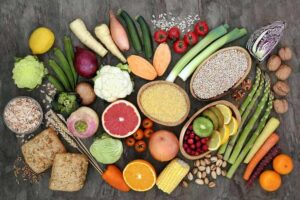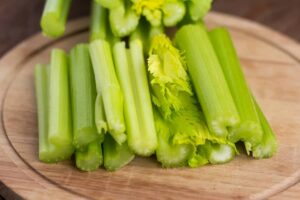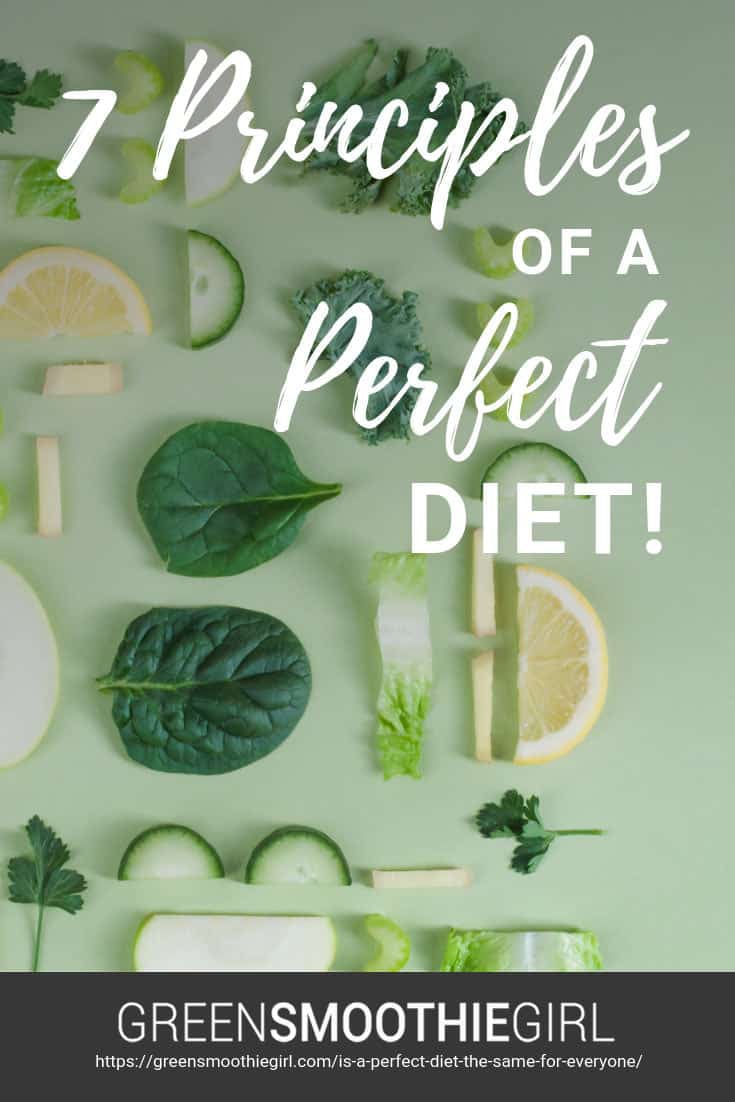Seven Principles of a Perfect Diet

For anyone paying attention, it seems the new “perfect diet” appears every couple of months and everyone leaps on the bandwagon. From Keto to Caveman, Paleo to Blood Type, Atkins to the Zone, diet trends monopolize the nutritional space, leaving little room for common sense or reliable science.
In this post:
This national – or even global – quest to find the magical “ideal diet” brings up a great question: Is there one perfect diet for everyone?
The answer is complicated, but the short version is that no, there is no one perfect diet for everyone on the planet. However, there are principles of the perfect diet that everyone can adopt to find an eating plan that helps them maintain optimum health.
Ultimately, a diet is a personal choice that’s uniquely crafted to fit your lifestyle, your health and wellness goals, and your eating preferences. But with over 10,000 studies documenting the longevity and minimized disease risk of eating mostly organic, whole plant foods, we must respect the evidence as well. All of us are 98 to 99 percent the same physiologically, despite varying ancestry and the trending concept of “bio-individuality.”
Plus, many modern Americans are suffering from food sensitivities and even allergies to healthy foods, which is likely a result of glyphosate (Roundup) on the food, genetically modified foods, processed foods, over-eating animal products, and taking many pharmaceutical products that damage the gut lining.
There may not be a one-size-fits-all solution for finding it, but using basic guidelines like the following “Seven Principles of a Perfect Diet,” you can customize your personal eating plan in ways that work for you.
PRINCIPLES OF A PERFECT DIET
#1: It feels abundant.
As a general rule, a diet should never eliminate an entire food group without exception. Of course, it’s okay to avoid specific foods – as in the case of food allergies or if you’ve chosen to be vegetarian – and there are definitely foods you should limit, like processed foods and sugar.
However, elimination diets like the Whole 30 or the No Carb Diet that forbid an entire macronutrient, food groups, or ingredients not only limit your taste buds, but they can limit your nutrition, too.
[Related: The Carnivore Diet: 11 Bizarre Claims of the All-Meat Diet]
Studies have found that eating a diet that includes a wide variety of foods is associated with better nutrient intake (including eating more fruits and vegetables), biochemical measures, and body composition among people at nutritional risk – like the elderly.1 Experts also recommend eating a wide variety of minimally processed foods as an effective way of reducing your risk of coronary heart disease.2

To make sure your body is getting optimal levels of nutrition that include all the different vitamins, minerals, and phytonutrients you need (along with the right proteins, carbohydrates, and fats to fuel your body), you’ll need to eat a wide variety of whole foods on a regular basis.

To ensure you’re enjoying an abundant diet, make a list of the greens, vegetables, fruits, legumes, nuts, seeds, and whole grains that you like to eat. Then, mix things up every time you head to the grocery store, buying different ingredients or adding new spices each visit.
You also can use apps like Pinterest or Pocket to note recipes that look interesting or unique. Using the foods you already love in new ways is a great way to make your diet feel brand new.
#2: It primarily consists of whole foods.
Whether it’s Ding Dongs or Doritos, or Fritos or fried chicken, potato chips or potato salad, most people have guilty pleasures. Your fantasy perfect diet might include all these treats (and then some), but in reality, no perfect diet involves processed foods.
Of course, you may decide to include some processed foods as part of your diet, but if you’re aiming for the “perfect diet,” you should aim to predominantly eat whole foods.
There’s some confusion about exactly what a processed food is,3 and in fact, it’s any food that’s been altered in any way during the preparation process. That doesn’t necessarily mean it’s unhealthy; canning, freezing, and drying are all considered “processing,” and canned, frozen, or dried fruits and vegetables all can be nutritious, though the less processed, the better, and nothing is better than fruits, veggies, greens, nuts, seeds, and legumes that you purchase and prepare yourself.
In general, when nutrition guidelines talk about “the dangers of processed foods,” they’re talking about items like:
- cheese
- bread
- crackers
- cereal
- microwave meals
- canned convenience foods (like chili or Spaghetti-os)
- boxed convenience foods (like Lunchables or Rice-A-Roni)
- bagged snacks like chips
- soda
- and other foods that have added fat, sugar, and salt.
On the other hand, whole foods are considered to be minimally processed after harvest and include:
- fresh fruits and vegetables
- whole grains – like whole oats, barley, brown rice or popcorn
- nuts and seeds
- meats in their natural form – like a chicken breast rather than a chicken nugget
Research has shown that eating whole foods makes a big impact on your health – specifically when it comes to your body mass index. Eating partially processed foods was associated with a 4% increase in BMI, while eating highly processed foods was associated with a 4.25% BMI increase, suggesting that eating partially processed and highly processed foods are major risk factors for being overweight or obese.4

#3: Any animal products are from clean sources and a minor part of the diet.
The question of whether or not you’ll include meat or animal byproducts like eggs or milk in your diet is a very personal one.
However, if you do decide to include animals or animal byproducts in your perfect diet, make sure those products are clean – meaning they’re organic, free range, or grass-fed whenever possible. It turns out Paleolithic men all over the globe did not eat meat twice a day, with protein up to 70 and 80 percent of the diet, like the “Paleo Diet” teaches, and millions of Americans follow. Instead, they primarily ate tubers, greens, grains, berries, and meat only occasionally when they could find it.
Studies have shown that these types of animal products are not only better for the environment, but they’re also more nutritious.
- Three decades of research found that when cows were fed grass-based diets, there were significant improvements in the fatty acid composition and antioxidant content in the beef – along with enhanced total conjugated linoleic acid isomers, trans vaccenic acid, and omega-3 fatty acids.5
- Grass-based diets for cattle may elevate precursors for Vitamin A and E and cancer fighting antioxidants compared to grain-fed diets.6
- Grass-fed beef has been shown to have overall lower fat content than grain-fed beef.7
- In chicken, research showed organic birds had higher protein content than convention birds, with lower levels of saturated and monounsaturated fatty acids and higher levels of polyunsaturated fatty acids.8
#4: It’s affordable.
When you think about a healthy diet, words like “organic,” “free-range,” or “all natural” might come to mind. While those types of products certainly can be healthy, they also can be very expensive.
Luckily, it is possible to eat a healthy diet without breaking the bank. In fact, your perfect diet must be affordable – or you’ll be forced to abandon it no matter how nutritious or delicious it happens to be.
The basic American diet often leans heavily on processed foods with the excuse that they’re much more affordable, but you can actually buy nutrient-rich whole foods without blowing your budget. In fact, studies have shown that the following foods provide high nutrient density at an affordable cost:9
- potatoes
- green beans
- carrots
- cabbage
- legumes
- whole-grain pasta
These foods are shown to be rich in protein, fiber, calcium, iron, potassium, magnesium, and vitamins A, C and E while also having low levels of saturated fat, added sugar and sodium.10 Of course, there are also many other nutrient-rich whole foods you can include in your perfect diet based on your personal budget and food preferences.
What Foods Should You Buy Organic? Tips For Deciding
When it comes to the “organic” question, if organic produce is too expensive, it’s better to use non-organic fruits and vegetables – at least for some of the produce you buy – rather than to skip these fresh foods altogether.
To decide when you’ll buy organic and when you’ll purchase conventional produce, think of a price point that makes buying organic worth the extra money. For example: is paying 20% more for organic produce acceptable? Can you only afford to pay 10% more?
Figure out what your personal price point is based on your family’s food needs and your grocery budget. Then, when you get to the grocery store or farmer’s market, you won’t have to worry; if organic produce isn’t available at your price point, you know you can buy the conventional fruits and veggies instead.
The exception to this rule is what’s called “the Dirty Dozen.” It’s a list created by Environmental Working Group that highlights the 12 fruits and veggies that are most contaminated by pesticides. I’ve put the list, plus other types of food with high pesticide contamination, onto a free printable wallet card you can take when you’re shopping. Bonus: the card also lists the “Clean 15” (the 15 produce items least likely to be contaminated), and several other foods that are safe to save your money and buy non-organic. Get that card here.
The good news is that eating right now can pay off later in a literal way. If you eat nutrient-dense foods that nourish your body and help you maintain a healthy weight, you’ll be less likely to develop diseases like diabetes or high blood pressure. Taking care of your body now can result in lower health care costs later.
#5: It’s sustainable.
Of course, it’s preferable to have a diet that’s sustainable for the earth, but in this sense, your diet should be sustainable for you. Sure, you can live exclusively on fruits and vegetables for a couple of weeks or even a couple of months, but ultimately, you’ll never stick with a diet it if it feels like you’re being deprived or if your body isn’t getting enough nutrition to keep it healthy and fueled.

This psychological aspect of the perfect diet is well-established in research. Studies have shown that just the intention of starting a new restrictive diet – without actually making any specific changes – is enough to make people overeat. In fact, when participants in one study were told they were going to diet for a week, they immediately began eating significantly more than those who were told they wouldn’t be dieting.11
Everyone has a guilty pleasure, whether it’s chocolate or French fries or wine (or all of the above!). The key to your perfect diet is to find ways to enjoy those pleasures on occasion, like one of those, once or twice a week (one of those every day still puts you at significant risk) – and to make the rest of your diet an organic, whole-foods, plant-based commitment.
If any aspect of your diet is unsustainable – because it’s too restrictive, it’s too expensive, or it’s too extreme for your current emotional state – then it’s really not the perfect diet for you.
#6: It makes you feel fueled and energized.
There’s no denying that food is pleasurable, and for many of us, it’s one of the ways we connect to our friends, families, and communities.
Still, at the end of the day, food is fuel, and your perfect diet should be filled with foods that leave you feeling healthy, energized, and ready to tackle your life.
That doesn’t mean you absolutely have to give up your favorite morning beverage if you enjoy it, but rather than relying on stimulants like coffee or energy drinks in the morning (or that sugar rush that gets you through your afternoon slump), you should aim to fuel your body with nutritious foods that will give you a calm, peaceful energy that lasts throughout the day.
[Related: The Best Breakfast Smoothie Recipes for Energy]
Of course, fueling your body properly will depend on your personal nutritional needs. You’ve probably heard about runners who “carbo-load” the night before a marathon to ensure their bodies have enough energy to make it through the big race. Athletes often work with trainers to fine-tune their diets for optimal performance.
While you may not need to go to such extremes, you do want to fuel your body with a combination of healthy proteins, carbohydrates, and fats on a daily basis. Choosing a wide variety of whole, nutrient-dense foods is a great way to ensure you get the right amount of calories and the vitamins, minerals, and micronutrients you need to sustain your body.
#7: It contains a lot of raw plants.
There’s a reason your mom told you to eat your vegetables when you were a kid. In fact, there are lots of reasons – plants are loaded with bioavailable vitamins, minerals, protein, fiber, and countless micronutrients. Every time you eat a plant, your body is soaking up all of the benefits and converting them into your improved health.
Raw plant foods are particularly important. Raw greens, fruits, vegetables, seeds, and nuts all provide the enzymes needed to digest and absorb them. Too many Americans are deficient in enzymes because their food is cooked or otherwise processed, which destroys enzymes. The only enzymes available are those their bodies make, and after age 30, the ability to make enzymes declines rapidly.

You don’t have to just take mom’s word for it. Tens of thousands of published studies show the benefits of eating plant foods. Among those benefits:
- Eating plants, specifically cruciferous vegetables, can protect against cancer.12
- Dietary carotenoids, which are found in high quantities in fruits and vegetables, prevent eye disease. 13
- Antioxidants and phase 2 enzymes in plants like kale, carrots, onions, spinach, broccoli, and Brussel sprouts may protect against cardiovascular disease.14
- Eating plant polyphenols can provide protection against cancers, cardiovascular diseases, diabetes, osteoporosis and neurodegenerative diseases.15
One of the greatest parts about adding raw plants to your perfect diet is that your options are almost endless when it comes to both selection and preparation. People across the world eat more than 200 varieties of fruit and vegetables – and there’s almost always something new to be discovered at the grocery store or your local’s farmer’s market. (You could even find a new raw plant to eat while you’re foraging on your next hike, though you should always take care to identify it and make sure it’s edible!)
When it comes to preparation, of course you can make a beautiful salad or enjoy carrot slices and zucchini sticks with a little easy hummus. However, if you make a green smoothie, your options for combining a wide range of plant foods all at once will multiply exponentially!
There is an endless array of healthy green smoothie recipes – and you can even create your own by simply combining your favorite raw fruits and veggies with healthy nuts, flavorful herbs and spices, and other ingredients you love. Smoothies are a sure way to boost your nutrition, satisfy your taste buds, and ensure you never get tired of incorporating those healthy raw plants into your perfect diet.
Conclusions About Creating Your Perfect Diet
The perfect diet is really just the sustainable diet that helps you meets your body’s needs and your own personal health and wellness goals. Make a list of foods you love to make and eat that also happen to be healthy; you can post the list inside a cupboard to consult when you hit a mental wall, or in your wallet to consult when you’re shopping.
Don’t be afraid to adjust as those goals a bit as your emotional state and resiliency change. Most people who eat an excellent diet didn’t make that change overnight; they added great new habits, one at a time, as they found what worked for them, like a quart of green smoothie a day works for me. Perfection isn’t a target – it’s a process. Embrace it, and your perfect diet will fall into place.
Read next: Healthy Travel Food: The Ultimate Packing Lists For Eating Right On A Trip
 Robyn Openshaw, MSW, is the bestselling author of The Green Smoothies Diet, 12 Steps to Whole Foods, and 2017’s #1 Amazon Bestseller and USA Today Bestseller, Vibe. Learn more about how to make the journey painless, from the nutrient-scarce Standard American Diet, to a whole-foods diet, in her free video masterclass 12 Steps to Whole Foods.
Robyn Openshaw, MSW, is the bestselling author of The Green Smoothies Diet, 12 Steps to Whole Foods, and 2017’s #1 Amazon Bestseller and USA Today Bestseller, Vibe. Learn more about how to make the journey painless, from the nutrient-scarce Standard American Diet, to a whole-foods diet, in her free video masterclass 12 Steps to Whole Foods.
Disclosure: This post may contain affiliate links that help support the GSG mission without costing you extra. I recommend only companies and products that I use myself.

SOURCES
(1) Bernstein, Melissa, et al. “Higher dietary variety is associated with better nutritional status in frail elderly people”Journal of the American Dietetic Association Volume 102, Issue 8, August 2002, Pages 1096-1104
(2)Tucker, K.L. “Dietary intake and coronary heart disease: A variety of nutrients and phytochemicals are important”Curr Treat Options Cardio Med (2004) 6: 291.
(3) National Health Service “Eating Processed Foods” Retrieved from: https://www.nhs.uk/live-well/eat-well/what-are-processed-foods/
(4) Abay Asfaw “Does consumption of processed foods explain disparities in the body weight of individuals? The case of Guatemala” Volume20, Issue2 February 2011 Pages 184-195
(5)(6)(7) Cynthia A Daley et al. “A review of fatty acid profiles and antioxidant content in grass-fed and grain-fed beef” Nutrition Journal20109:10
(8) R. L. Husak J. G. Sebranek K. Bregendahl “A Survey of Commercially Available Broilers Marketed as Organic, Free-Range, and Conventional Broilers for Cooked Meat Yields, Meat Composition, and Relative Value” Poultry Science, Volume 87, Issue 11, November 2008, Pages 2367–2376,
(9)(10)Drewnowski A, Eichelsdoerfer P. Can Low-Income Americans Afford a Healthy Diet?. Nutr Today. 2010;44(6):246-249.
(11)Urbszat D, Herman CP, Polivy J. “Eat, drink, and be merry, for tomorrow we diet: effects of anticipated deprivation on food intake in restrained and unrestrained eaters.” J Abnorm Psychol. 2002 May;111(2):396-401.
(12)Talalay, Paul, et al. “Phytochemicals from Cruciferous Plants Protect against Cancer by Modulating Carcinogen Metabolism”
The Journal of Nutrition, Volume 131, Issue 11, November 2001, Pages 3027S–3033S
(13)Johnson, EJ “The role of carotenoids in human health.” Nutr Clin Care. 2002 Mar-Apr;5(2):56-65.
(14)Blomhoff, Rune “Dietary antioxidants and cardiovascular disease” Current Opinion in Lipidology: February 2005 - Volume 16 - Issue 1 - p 47–54
(15)Kanti Bhooshan Pandey and Syed Ibrahim Rizvi, “Plant Polyphenols as Dietary Antioxidants in Human Health and Disease,” Oxidative Medicine and Cellular Longevity, vol. 2, no. 5, pp. 270-278, 2009.
Posted in: Healthy Weight, Lifestyle, Whole Food













